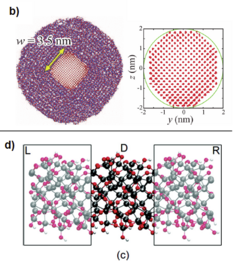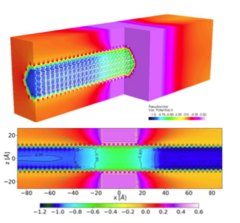Dr. Jun Li

Fields of interest | Fast algorithms for quantum transport Software development for nano-electronics simulation package |
| Publications | ISI Web of Science |
Research
My research focused on the fast algorithms in NEGF approach for steady-state quantum transport. The application of NEGF in quantum transport has led to tremendous success for the simulation of nano-device. However, the intensive computational cost in NEGF prohibits its application to realistic system at large scale, especially the device with multi-terminal setup. The major part of cost in self-consistent field (SCF) NEGF calculation comes from the evaluation of electron density, or Mulliken charge, which is obtained by numerical integration of Green’s function:the equilibrium part and non-equilibrium part.
An approximate framework for quantum transport calculation with model order reduction

A new approximate computational framework is proposed for computing the non-equilibrium charge density in the context of the non-equilibrium Green's function (NEGF) method for quantum mechanical transport problems. The framework consists of a new formulation, called the X-formulation, for single-energy density calculation based on the solution of sparse linear systems, and a projection-based nonlinear model order reduction (MOR) approach to address the large number of energy points required for large applied biases. The advantages of the new methods are confirmed by numerical experiments.
Fundamental Limit to Scaling Si Field-Effect Transistors Due to Source-to-Drain Direct Tunneling

How far can the miniaturization of metal– oxide–semiconductor field-effect transistors (MOSFETs) continue is a recurring question, essential to all aspects of digital technology. Recent claims of well-performing MOSFETs with gate lengths below 4 nm apparently defy the fundamental limit of source-to-drain direct tunnel- ing (SDDT). Here, we investigate that limit by simulating gate-all-around Si nanowire FETs with gate lengths between 8 and 3 nm using the state-of-the-art atomistic quantum transport modeling. We find that at 3-nm gate length, the current is dominated by SDDT, resulting in large source– drain leakage and poor switching performance even if the gate modulates the potential barrier between the source and drain sufficiently well. However, at 6-nm gate-length SDDT barely starts to degrade the subthreshold characteristics at large drain bias, and the ballistic ON-/OFF-current ratio is ∼106 with a subthreshold swing of 70 mV/decade, on par with contemporary Si technology. This means that in the best case, the technology roadmap could potentially be extended for several generations beyond the currently pro- jected nodes. In addition, the results substantiate that the experimental devices with the claimed gate lengths below 6 nm in fact operate with a longer effective gate lengths.
